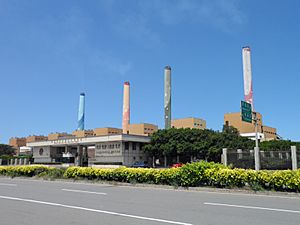Base load facts for kids

Imagine a city always needs a certain amount of electricity, even in the middle of the night. This minimum amount of power that is always needed on an electrical grid is called the base load. It's like the constant hum of electricity that keeps homes, hospitals, and streetlights working all the time.
This steady need for power can be met by power plants that run all the time, like large coal or nuclear plants. These are often called baseload power plants. However, the base load can also be met by a mix of different power sources. These include ones that can be turned on or off easily, or even many smaller sources that don't always produce power.
The amount of electricity people use changes throughout the day. For example, more power is needed when everyone wakes up or comes home from school. This changing demand is met by power plants that can be turned up or down quickly. These include plants that follow the changing power needs or ones that only run during peak times.
Contents
What is Baseload Power?
Power plants that do not change their power output quickly are usually called baseload power plants. These often include large coal or nuclear plants. Historically, most of the base load demand was met by these types of plants.
However, new ways of getting power, especially from renewable energy sources, are changing this. Modern power systems often use a mix of different energy sources. This means they can be more flexible in how they meet the constant power needs.
How Grid Operators Manage Power
People who manage the electricity grid are called grid operators. They work to make sure there is always enough electricity for everyone. They do this by balancing the amount of power being made with the amount being used. This is a continuous job, happening all the time.
In the past, large power grids used big, steady power plants to meet the base load. But there is no rule that says it has to be this way. The base load can also be met by a good mix of different power sources. This includes sources that don't always produce power, like solar or wind, combined with others that can be controlled.
Types of Baseload Power Plants
Power plants that can run steadily for a long time include:
- Coal plants
- Nuclear plants
- Combined cycle plants (often using natural gas)
- Hydroelectric (power from water)
- Geothermal (power from Earth's heat)
- Biogas and Biomass (power from organic materials)
- Solar thermal plants that can store heat
- Ocean thermal energy conversion (power from ocean temperature differences)
Some power sources can be controlled or "dispatched" when needed. These include some natural gas plants, wind farms (by adjusting their blades), and hydroelectric dams. Grid operators can also "curtail" or temporarily shut down plants if their energy is not needed.
The Cost of Baseload Power
Grid operators try to find the cheapest ways to get electricity. They look for the best prices for power over short and long periods.
Nuclear and coal plants are very expensive to build. But once they are running, the cost to produce each extra bit of electricity is very low. They are designed to run almost all the time.
On the other hand, power plants that only run during peak times, like some natural gas plants, are cheaper to build. But the cost to produce electricity from them is higher. They are not meant to run all the time.
Coal and nuclear power plants usually run at a constant level. This is because it is more cost-effective for them to operate this way. Also, not all power plants are built to change their power output quickly. However, some nuclear power stations, like those in France, can change their output to help meet changing power needs.
Some combined-cycle plants, which often use gas, can provide steady baseload power. They can also be turned up or down to match faster changes in how much power is being used.
Some experts, like Steve Holliday, who used to be the CEO of National Grid plc, believe that the idea of "baseload" is becoming old-fashioned. This is because new technologies and more renewable energy sources are changing how we get and use electricity.
See also
- Capacity factor
- Energy demand management
- Grid energy storage
- Load balancing (electrical power)
- Smart grid
- Load following power plant
- Peaking power plant
 In Spanish: Carga base para niños
In Spanish: Carga base para niños


